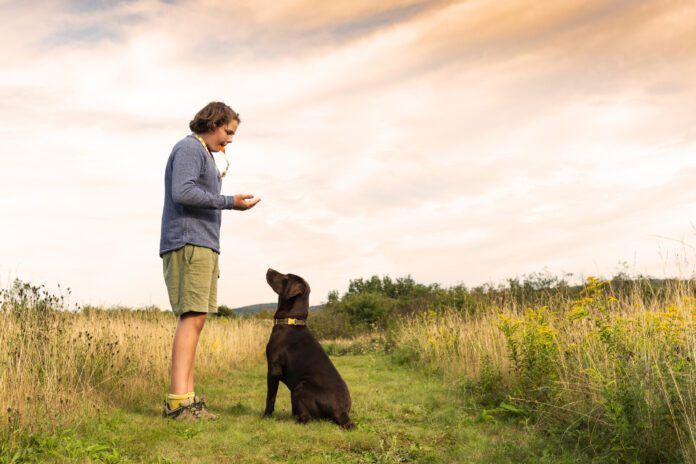Dogs can learn to respond to all sorts of sounds and cues, but among the most effective for a solid recall, or “come,” is a whistle. While you don’t need a special dog training whistle—and we don’t think there is a “best dog whistle”—you should consider a fixed-pitch whistle, such as the Acme 211.5 whistle, because consistency is important in training.
In this article, we are going to explain how to use a dog whistle to teach a recall. We’re not going to discuss using a dog whistle to stop barking. We want a whistle to be a positive cue to do something, not stop doing something.
Why Train Your Dog to a Whistle
A dog whistle can get your dog’s attention better than your voice, especially because voices can reflect emotion, like panic, excitement, or even anger. A whistle is consistent.
Before we start, the benefits of training your dog to come to a whistle include:
- If your dog is starting to lose his hearing, the whistle will often still be heard even when he can no longer hear your voice
- If you have inadvertently poisoned your “Come” cue, the whistle is a great alternative
- If the dog gets lost, the whistle sound travels much farther than a verbal recall
- The whistle can be heard over nature’s sounds even the surf, thunder, rain, etc., and even manmade sounds like a generator or loud trucks
- The whistle is never annoyed, angry, scared, or panicked—it sounds the same every time
The relationship between you and your dog must be in place first before working on the whistle. Start by dropping any negativity. Stop all physical and verbal punishments, including the word “No.” Why? “No” easily escalates into a screamed “No!” dredging up negative emotion, which is then transmitted to the dog.
Before we discuss the actual whistle, we need to have a few things in place first:
- Eye contact
- Name response
- A verbal recall cue
If you’ve poisoned your dog’s name or verbal come cue—meaning those words mean nothing to your dog because you have used them inconsistently—now is the time to change them.
Grab a clicker, have a handful of small high-value treats. Click once and hand the dog a treat (within a half second). Repeat for two solid minutes. You should never need to do this step again.
In the same session, grab another handful of treats, put your food hand behind your back and wait. Pretty much 99% of dogs will look up at your face and ask, “Why did you stop?”
- The instant he looks at you, click and treat (C/T) and don’t say anything. Repeat for two to three minutes, two to three times per day. You can’t train a dog to do anything if they aren’t willingly looking at you.
- Next up is name response. Same session: When dog looks at your face, say his name, C/T. Do not say anything to get him to look at you. Just silently wait.
- Same session, adding in a verbal recall. Without moving, when dog looks at you, say his name, take a short breath, and then your come cue, then C/
- Why no movement? We discuss that below.
Practice the C/T Response
Practice items 1-2-3 two to three times per day, two to three minutes at a time in as many locations as you can (on leash if not in a fenced in area). Dogs don’t generalize. What they learn in the kitchen stays there. Start with quiet places and then gradually go to busier places with slightly more distractions. Still just eye contact, then eye contact plus the dog’s name, then eye contact plus the dog’s name plus “come.” Don’t skimp on these steps. If your dog has a history of ignoring you, we need to change that now. And, don’t forget to breathe.
- Add this to items 1-2-3. Same session. Now we’ll start to create a Conditioned Response (CR) to the whistle, so that the dog won’t hesitate to respond.
Three times per day for about two to three minutes per session, for 14 days, you will “prime” the whistle in this pattern. Two short toots and one really long toot and hand your dog a treat within a half second.
You aren’t asking the dog to move. He just hears the sound and gets a treat. I don’t want you or your dog to move. We are doing what’s called “back-chaining,” where you train the last piece of a behavior first. What is the last piece of any recall? The dog will be right in front of you, so they learn that the position and sound pay off quickly.
Practice in as many locations as you can, gradually going to areas with more distractions. Still, don’t ask the dog to move. Don’t cheat! We must build up a foundation first.
Once in a while, I’ll get a dog who is afraid of the whistle. If you do one toot and he hits the dirt in abject fear, do NOT try it again. Test your dog with a squeaker from a toy. If your dog is OK with that, then just use the squeaker as your “whistle.”
Now Let’s Get Moving
You’ve been working on eye contact (attention), name response, come response and priming the whistle, for at least 14 days. Now it’s time to start moving!
Game #1: Drop the Treat and Run
- Drop a cookie. Make sure dog sees it! If a dark substrate, use white cheese or chicken. If a light substrate, use a darker treat.
- Tell dog to “Get It.”
- Run away fast! Keep looking back to your dog. If you don’t look back, you won’t know when to whistle him in. The instant he starts to chase you, stop, turn and face him.
- As he’s coming, say his name, take a short breath, then say “Come” or whistle without saying his name. You’re pairing the word or sound with the behavior.
Don’t use a verbal cue and a whistle at the same time. Rotate it between the verbal or the whistle. Keep it to one or the other in each session. Reward with a huge jackpot. What’s a jackpot? It’s not two or three treats! I use 10 to 20 treats, sized appropriately for the dog. Feed one treat at a time. We’re building up a reinforcement history here, so you MUST be generous, each and every time, because a recall is THE most important behavior you can teach your dog. You may also add in tons of praise, petting and play.
What we’re doing here is to get the dog to move away from you, so you can get a head start, to then chase you (dogs love to chase) and then “name” the behavior AS it’s happening.
At NO point should you whistle your dog in if he isn’t already on his way.
You’ll play this game for an entire week, starting in a low distraction location and gradually building up to higher distractions. If you’re in a fenced area, you won’t need a leash. If no fence, use a 30-foot long line.
Game #2: Toss the Treat Farther and Don’t Run
We need to start fading out the running part of game #1, so for this step, you’ll toss the treat much farther, which means at least 20 feet away (be sure to use a much bigger white treat for this so the dog can find it in the grass) and don’t run.
Because you’ve practiced game #1 for a solid week, he will have learned the pattern: Grab the treat and race back to you! This should be easy for him. As he’s on his way back, do your whistle pattern and heavily jackpot, with food, petting, praise and play.
Practice this game for a solid week, again, starting with low distractions, gradually adding in other distractions. If you’re in a fenced area, you won’t need a leash. If no fence, use a 30-foot long line.
At NO point should you whistle your dog in if he isn’t already on his way.
Game #3: Let the Dog Get Slightly Distracted Game
Now we need to fade out not only the running away, but also the cookie toss. If you don’t, the dog won’t come unless you throw the treat and/or run away. Not conducive to the real world.
We start in a low-distraction area. Stand still and be boring. Don’t look at your dog. You can even pretend to talk on your phone. Keep your peripheral vision on him though. When he is about five to six feet away, do one toot and if he responds by turning toward you, finish up the pattern (two short toots and one really long toot) and then jackpot with tons of food, petting, praise, and play.
Practice this for a few reps and then let him go farther away before you do the one toot and then finish up the complete whistle pattern. If you’re in a fenced area, you won’t need a leash. If no fence, use a 30-foot long line.
Gradually let him get increasingly distracted, but don’t go from six feet to 20 feet. That’s setting him up to fail.
Work on these three games for a week each and check in for more steps!
Putting Dog Whistle Recalls to the Test
At this point, your dog should be responding beautifully to his name, and appropriately to the whistle in low to medium environments. I’ll bet you can’t get rid of him!
Now we’re going to increase the scenarios.
Go for a Walk – Part One
Take your dog for a walk either off leash (in a safe area) or on a 30-foot long line. When (not before) he checks in (looks back to you), do your whistle pattern (two short toots and one really long toot) and heavily reinforce with a jackpot of treats, petting, praise and play. The verbally release the dog to go be a dog. Repeat this as many times as it takes for your dog to be checking in every 30 to 60 seconds.
Go for a Walk – Part two
Start to whistle BEFORE they check in. There is a real knack for recognizing what is a good time and what is a bad time to try this. Be attentive to potentially high distractions, so as not to attempt the recall when dog might be in conflict. Set up for success!
If you’re not 100% positive he’ll respond, do a “questioning” toot and if he responds, finish up with the pattern. If he doesn’t start to come toward you, do NOT try it again at that moment. Wait, watch for perhaps less sniffing and try it again. When he does look to you, finish up your whistle pattern.
Troubleshooting: What if the dog still doesn’t respond to the whistle? At this point, they should. However, if they don’t, don’t repeat the whistle. Just wait and judge a better time to whistle them in. If you’re working with a dog who ignores it a second time, just review the “whistle them in when they’re looking at you.”
The Liar’s Game
“Come with distractions” is probably the most important behavior you will teach a dog. There are many different games we can use to teach this essential behavior. This game teaches the dog that YOU are always a “sure bet” and everyone else in the world is a liar:
- Toss the treat far. Your “liar” will stand in the middle of the yard with some food or toy. The liar has something of relatively low value to the dog. We want to set him up for success!
- Handler runs across the room or yard.
- Call (verbally to start) dog to come.
- The liar tries to (minor – don’t go full bore on this yet) distract the dog. The liar does NOT let the dog have any goodies or give eye contact.
- Do NOT repeat your cue. Just wait.
- When dog looks at you, whistle him in and treat with a huge jackpot.
- Repeat until the dog is actively avoiding the liar.
Then, as always, gradually increase the distraction and you should get to the point pretty quickly that you can just whistle the dog in without saying his name first.
Increase the value of the objects that the liar has, making sure that YOUR jackpots rise in value also. Add some additional liars and have a few people trying to distract the dog away from his mission of coming to you. Note: Do not use family members as liars.
Hide-and-Seek
Take your dog for a walk on a long line (or off leash in a safe area) and when he isn’t looking at you, hide behind a bush or tree but make sure you can still see him. Say his name once (so he can orient to you) and when he comes running back, whistle him in. BIG party! Food, petting, praise, treats.
Once there is no hesitation, instead of saying his name, just whistle him in.
Keep It Green
As with everything in life, you will need to periodically “prime” the whistle and play some of the games, otherwise your dog may get rusty and not respond as he once did.






